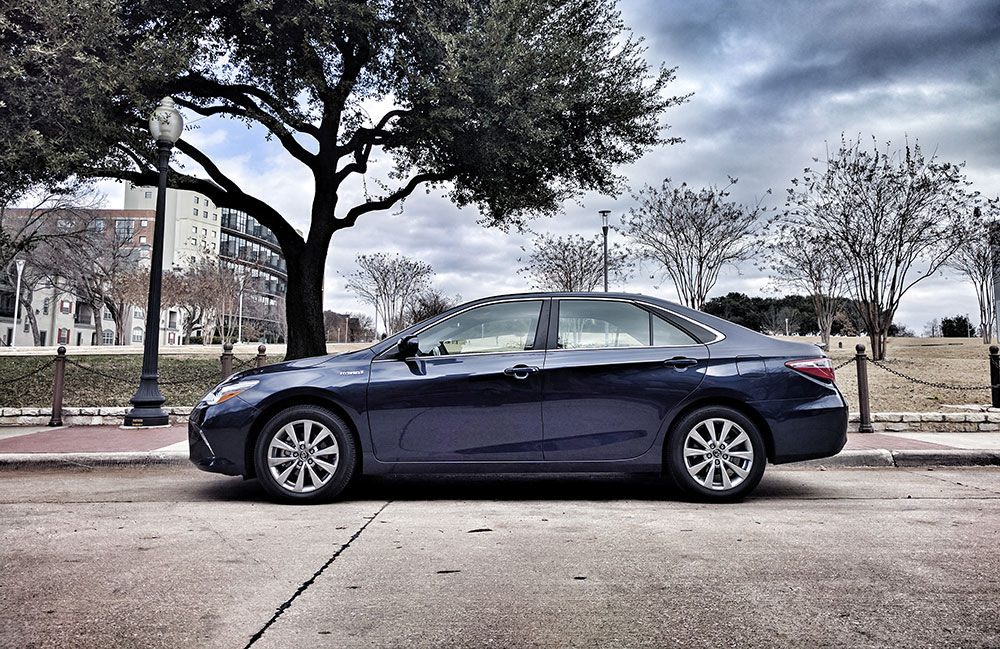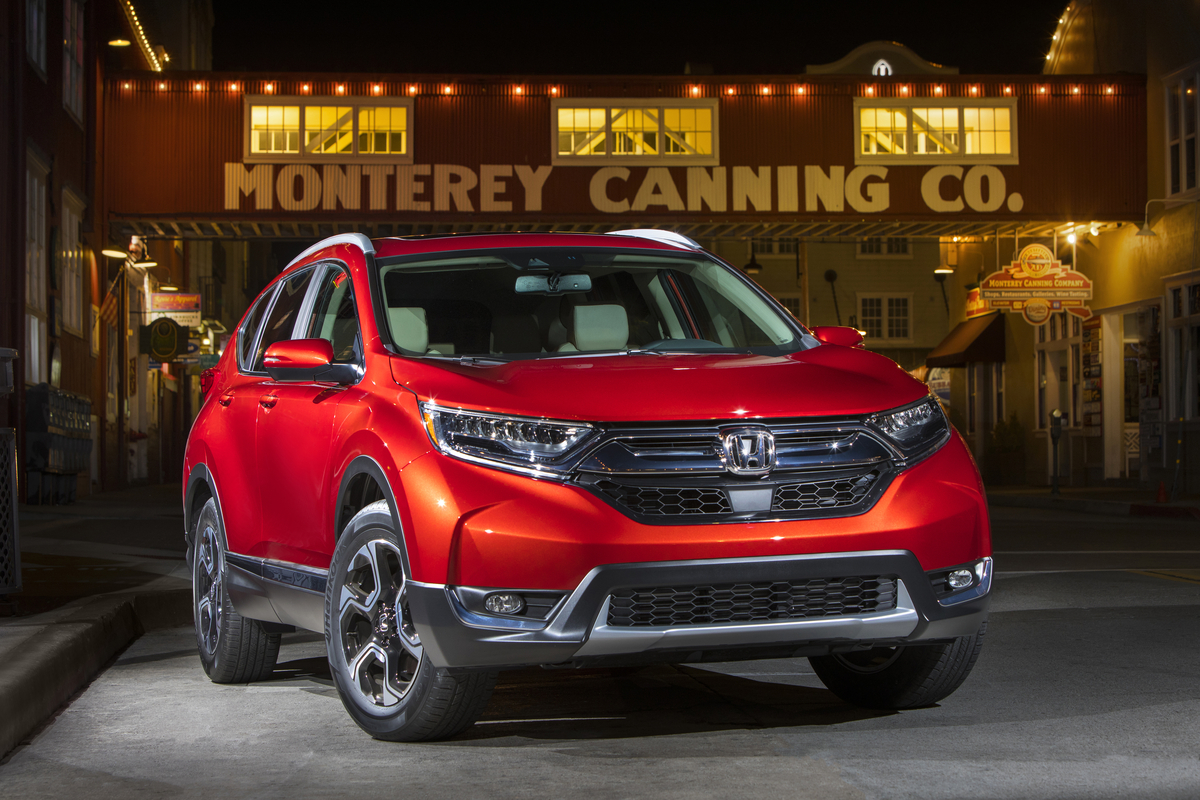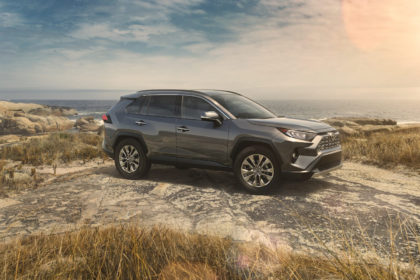There is no denying it: the upcoming 2018 Toyota Camry looks pretty dope. Toyota has reinvented one of American’s best-selling cars and once the new Camry officially goes on sale later in 2017, the Japanese automaker is bound to have another home run on their hands. But unless you’re a die-hard fan that must have the latest and greatest model, most consumers most likely won’t be waiting in line for the new Camry, especially if they’re already in the market for a sedan right now. So let’s assume you’re one of those car buyers who are considering a new Camry in the very near future. Here’s the question I have for you: is the hybrid version a consideration? If it isn’t, it should be. It’s a darn good time for hybrids and the 2017 Camry Hybrid is very near the cream of the crop.
Old Reliable
There’s a reason Camrys sell so well; they are dependable, reliable and will last well past 200,000 miles if you care for it properly. I know this to be true first hand – my aunt and uncle have a 2004 Camry with well over 250,000 miles in the rearview mirror and it’s still chugging like a car in its prime. So, we know Camrys kick ass but how well does the Hybrid version fair? Short answer: not too shabby at all.
Since the beginning of the Camry’s seventh generation in 2011, they have consistently carried forward with a classic sedan shape that embodied both class and functionality. In other words, Camrys are still easy to spot at first glance. You’d be hard-pressed to describe it as an “edgy” or “flashy” car but it has always been undeniably modern and quite handsome. In 2014, the Camry received a slight facelift with the most notable outward feature being the wide grill that opens wider as it approaches the ground. It can be argued that this mildly aggressive grill doesn’t exactly jive with a “family sedan” design but there is no rule that says that a family car can’t have a little personality. I’m also a fan of the slanted HID running lights that flank the grill; it’s a small element that is undeniably modern.
Inside, the 2017 Camry is a bit more conservative and traditional but that’s actually a refreshing departure from what has become all the “rage” in modern car design these days: jagged, overly-edgy, chunky interior designs. Among the small refinements that Toyota brought to the table in its 2016 Camry is a larger cabin and a simpler layout of controls and knobs. In the 2017 model, extra space is especially noticeable. The interior is very spacious with considerable leg room for both passengers and storage. I particularly enjoyed the extra wide driver and passenger bucket seats. Compared to vehicles in the same class – like the Honda Accord – seating in the Camry feels like “First Class” versus “Coach”.
The large controls on the dash in the XLE model surrounds a large 7.0-inch touchscreen, making navigation of Toyota’s user-friendly infotainment suite a breeze; other Camry models come equipped with a slightly smaller 6.1-inch touchscreen. There is also some modest stitching across the dash that add some nice texture details, particularly around the leather-trimmed steering wheel. The leather wrapped front seats with lumbar support is a nice addition that is usually only found on luxury cars; plus the heated seats did an excellent job of warming up the ol’ buns quite nicely. Additional tech features create an additional level of convenience – like the keyless entry/Push button start feature – while others seemed unnecessary – like the Qi Wireless Charging plate to wireless charge phones. Not many modern mobile phones carry this wireless charging technology, so it’s puzzling why some manufacturers still include it.
If you’re an audiophile, rejoice! The JBL audio system is a joy to experience. A well rounded soundscape was beautifully created by ten speakers blanketing the cabin with fantastic highs and lows. JBL continues to impress in the entirety of Toyota’s lineup; seriously, jump into a Toyota vehicle equipped with a JBL speaker system and crank it up. Your eardrums will weep with joy. And it doesn’t hurt that the 2017 Camry compliments this sound system with a noticeably quiet ride; an acoustic windshield aids in keep wind noise out while on the road.
Consistency is Best
Here’s what we all came for: the 2017 Camry’s Hybrid engine. If you aren’t familiar with last year’s Camry Hybrid model, not much is changed this year so all you need to know is that Toyota took what works well in their popular Prius vehicle and ported it into the Camry. A 2.5-liter inline-4 ECVT engine is combined with a nickel-metal-hydride battery system that, in total, creates 200 horsepower. The ECVT acronym stands for “Electronically controlled Continuously Variable Transmission” and what it basically does is allow the engine to use a range of gear ratios to maintain a constant velocity. This means continuously smoother acceleration, which is important for an engine that will rely on both a traditional engine and a battery.
All the joys you’d expect from a Hybrid vehicle are present and accounted for in the Camry Hybrid: namely efficient fuel economy. Toyota says that their Camry Hybrid gets 40 mpg city and 38 highway – a fairly accurate statement. During my week long test, I landed more in the range of 37mpg city and 34mpg highway but I admittedly drive with a bit of a heavy foot. What is amazing to experience firsthand though, is jumping into the driver’s seat, turning on the engine, and see this on the speedometer:
Yep, a full tank of gas in the Camry Hyrbid will take you down 636 miles of road before needing a refill. That’s pretty darn impressive and admittedly invokes a sense of futuristic giddiness. This is what the future looks like and it makes the price tag worth every penny.
Of course, killer gas mileage wouldn’t mean anything if driving the car was an unpleasant experience. Thankfully, it isn’t. Smooth and quiet, the Toyota Camry handles just as well as it has for the past few years – better in fact. Turning radiuses feel a bit tighter than years past and there is a undeniable sense of being tied to the road that is both comfortable and empowering. Braking is a little too abrupt for my tastes but I imagine they would appeal to safety conscious drivers.
Acceleration was surprisingly adequate, even during the transition from battery to engine. Drivers shouldn’t expect to much more than 0-60 in a little over 7 seconds, but even then, that’s not half bad for a sedan this size.
Playing the Waiting Game
Toyota is definitely taking the Camry in a bold new direction later this year and we won’t know for sure how it will compare to this past year’s model, let alone the hybrid version. For any vehicle on the market, entering a new generation can be exciting, if not uncertain. But there is something to be said about the last and final model in the previous generation’s line. Being the last Camry Hybrid that will look and drive like this 2017 model has its advantages. Toyota has worked out a lot of the kinks in this current generation and this 2017 model should be the pinnacle of the Camry line.
For now, anyway.
The automotive industry is moving faster every year and the hybrid sedan category isn’t what it used to be. Most of the major manufacturers have their own answer to the Toyota Camry, each with their own pros and cons, but because of the Prius it certainly feels like Toyota has been at this the longest. Does this mean that the 2017 Toyota Camry Hybrid the king of hybrid sedans? Not quite. Hyundai’s Sonota Hybrid model still stands out as the most ideal overall choice in my opinion. That being said, this Camry runs a very close second.
The 2018 Camry will finally catch up aesthetically to modern car design, but if you’re satisfied with a more classic Camry appeal with great gas mileage, then there is no need to wait.
The 2017 Camry XLE Hybrid starts at $30,140. Tested at $36,988.











